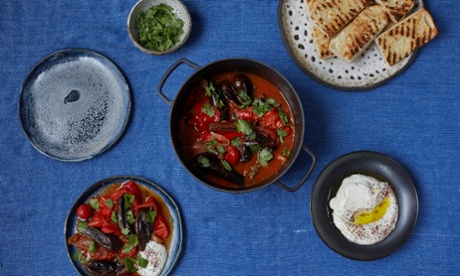The best food writing stays with you far longer than the time it takes to read the words on a page. Maybe you're drawn to evocative prose, or a nugget of advice resonates and suddenly makes everything clear. It could be that a recipe stands out, calls to you, and you go on to create it with great success, time and time again. Or it could simply be that a theme or a pairing of ingredients is new and inspiring.
Cookery books and recipes have probably been my primary source of food education. Of course, I'd like to think that intuition plays a part in what I cook and why. Ditto the experience of eating out, travel and watching others work. But I devour words. They're so often the spark for a weekend in the kitchen, the reason I know what flavours go together and what methods work best.
I tend to scan for ideas first, then dive in deeper when elements of a dish or a particular paragraph catch my eye. Sometimes I'll follow a recipe exactly. But more often than not (and I can't be alone in this), that recipe triggers an idea and I'll go off at a tangent; though I'll remember and note the source.
Every Monday, I publish a digest of the recipes in the weekend newspapers on my blog. I've been doing this for about 18 months now. At times, the process of reviewing and writing can be a slog (usually about 10pm on a Sunday when everyone else is finishing the red wine or watching Homeland or both). But each week, without fail, there'll be a clutch of recipes that are stimulating and refreshing and that, consciously or subconsciously, I'll emulate in some way. The recipes below have undoubtedly evolved from the works of others, though of course I think they're delicious in their own right.
Tomato and fennel tart with basil tapenade dressing
A year ago, I cooked a quite wonderful Rowley Leigh tomato tart. It stood out, because it had a base of finely diced fennel in a thickened slick of egg and cream. I now can't imagine making a tomato tart without that. His pastry was shortcrust, but I much prefer tomatoes on and surrounded by puff pastry " there's just something about the flaky butteriness that suits cooked tomatoes. The tapenade-like dressing cuts through the acidity of the tomatoes and the rich base.

Serves 6-10, depending on hunger
1 large fennel bulb, very finely diced
2 sticks of celery, very finely diced
125g double cream
2 egg yolks
750g large red tomatoes
Sea salt
375g pack ready-rolled all-butter puff pastry
Extra virgin olive oil
For the dressing
50g kalamata olives
20g capers
3 anchovies
40ml olive oil
Juice from ½ lemon
20 basil leaves
4 sprigs of thyme, leaves only
1 Make the fennel base in advance, as it needs to cool: sweat the fennel and celery in a little butter for 10 minutes until soft and sweet. Add the cream and cook for about 2 minutes " it'll just coat the vegetables. Season and cool to room temperature. Stir in the egg yolks and place in the fridge until needed.
2 Preheat the oven to 200C/400F/gas mark 6. Slice the tomatoes about 5mm thick. Put these on a plate, sprinkle with salt and leave for 10 minutes to remove some of the juices.
3 In the meantime, roll the puff pastry out on to a floured baking sheet. Use the back of a knife to score (not cut) a line 1.5-2cm in from the edge, all the way round the rectangle. Spread the fennel mix over the middle of the pastry up to the line.
4 Arrange the tomato slices in overlapping lines across the tart. Once assembled, drizzle a little olive oil over the top and place in the oven. After 20 minutes turn the heat down to 170C/335F/gas mark 3-4 and cook for 20 minutes more.
5 Meanwhile, make the olive dressing by finely chopping the olives, capers, and anchovies. Put these in a mixing bowl. Add the oil from the anchovy tin, the olive oil and lemon juice. Finely slice 10 basil leaves and add to the dressing with the thyme leaves. Set aside.
6 When the tart's 40 minutes is up, turn the heat up again to 200C/400F/gas mark 6 and cook for 5-10 minutes more until the pastry is brown and crisp. Remove the tart from the oven and leave to cool a little; you want to serve it warm, not hot.
7 Tear the remaining basil leaves and drizzle the dressing over the tart just before serving. Eat with a crisp green and bitter leaf salad.
Baby aubergine stew
There's no single reference point for this stew. But it owes much to years of reading the likes of Claudia Roden, Sam and Sam Clark, Diana Henry and Yotam Ottolenghi " why else would I add honey, cinnamon and cumin to what would otherwise have been a more intuitively Mediterranean mix? Also, I keep seeing baby aubergines in weekend recipes, and that makes me want to cook and eat them.

Serves 4
500g baby aubergines, top trimmed but otherwise whole
250g sweet marconi peppers, top trimmed and quartered lengthways
2 banana shallots, quartered and separated into leaves
A bunch of fresh coriander
2 garlic cloves, minced
Dash of red wine (optional)
400g tinned plum tomatoes
1 tbsp honey
1 tbsp cumin seeds, toasted and pounded
1 tsp chilli flakes
A handful of fresh thyme sprigs
1 small cinnamon stick
250g cherry tomatoes
1 tbsp sherry vinegar
Salt and black pepper
40g toasted almond flakes
1 Fry the aubergines in a large pan over a very hot flame for 5-10 minutes, until they blacken and wrinkle. Remove from the pan and do the same with the peppers.
2 Sweat the shallots in a large casserole for 5-10 minutes until soft and sweet. Finely chop only the stems of the coriander and place in the shallot pan with the garlic. Cook for 30 seconds then turn the heat up and add the aubergines and peppers.
3 Deglaze the pan with a glug of red wine, if you have it. Add the tinned tomatoes. Refill the tin with water and pour that in too. Add the honey, cumin, chilli flakes, thyme and cinnamon stick. Turn the heat down and cook with a lid on for 30 minutes.
4 Remove the lid, add the cherry tomatoes and cook for 20-30 minutes more, until the aubergines are almost collapsing, the cherry tomatoes split and yielding, and the sauce a little thickened. Season with the sherry vinegar, salt and pepper to taste.
5 Roughly chop the coriander leaves and add half of these and half the almonds to the stew. Stir. Sprinkle the rest over the top of the serving dish, or people's bowls. Serve with Greek yoghurt sprinkled with sumac and flatbread or couscous.
Ed Smith is a food writer and blogs at rocketandsquash.com. Twitter: @rocketandsquash









